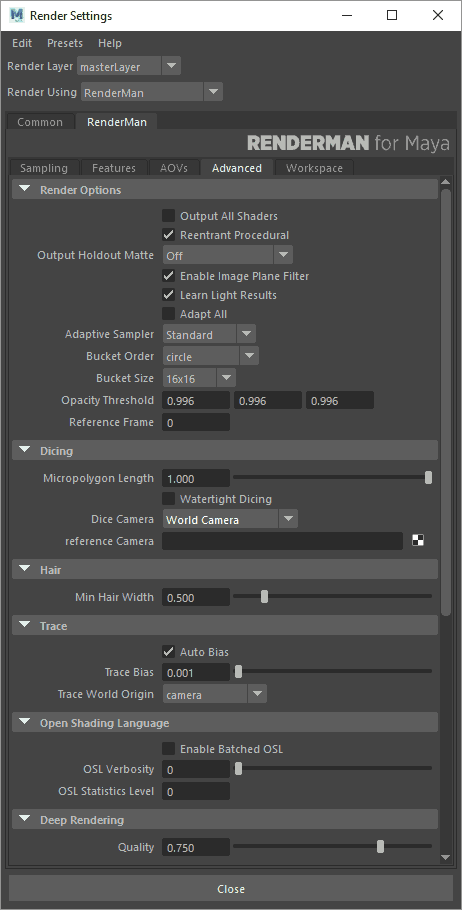Many of the settings in the Advanced Tab you will never need to edit. However, for the more advanced user who wants fine tuned control over RenderMan for Maya, they are here.
Render Options
Output All ShaderShaders: Typically we export only material networks attached to objects, but if you're shading a procedural it may not be connected in a way that is exported. This option will export all networks regardless.
...
Output Holdout Matte: When using the Holdout workflow, output the Shadow AOV to this specified buffer.
...
Opacity Threshold: Controls the Opacity Threshold, if set too low, it may terminate rays early on semi-opaque objects. An objects opacity is controlled by the material Presence parameter and depth in supported integrators.
Reference Frame: Once per job passes and static objects are evaluated at the frame designated here.
...
Dicing Camera: Enables the use of a reference camera for dicing. This can be done globally, or restricted to specific objects (e.g. objects with displacements that "sparkle" as the camera moves) by also attaching this as a per-object attribute.
Reference Camera: Specify the camera to be used as your dicing camera here. Click on the widget to create a new camera, or right click in the field to select an existing camera. Note that the Reference Camera needs to be different from the render camera.
...
- "world" (default) uses the true world origin
- "worldoffset" use user provided trace:worldoffset as the raytrace world origin ( the control will expose an XYZ coordinate field)
- "camera" use the camera position as the raytrace world origin, you may wish to use this in large scenes with multiple camera positions as the default.
Open Shading Language
Enable Batched OSL: Enable performance improvements on batched shading points through vectorized instructions on supported hardware. (Available on machines with a minimum of support for Advanced Vector Extensions (AVX). Additionally, it can take advantage of the 512-bit wide datapaths on machines that support Advance Vector Extensions 512 (AVX-512). This is on by default
OSL Verbosity: Valid in ranges of 0 to 5 with 5 having the most messages. See the OSL documentation for more information.
OSL Statistics Level: As above, valid in ranges of 0 to 5 with 5 having the most messages.
Deep Rendering
Quality: Controls the decimation rate of merging samples. A setting of 1.0 has no merging of samples and will generate huge files. The default of 0.75 maps to Deepshadow Error 0.01 and when set to 0 maps to Deepshadow Error 0.16. Note this is not a linear mapping.
Crop Window
Enable: Use the crop window, off (default) renders the complete frame based on camera settings
...
Level: Enable this to output diagnostic information from render jobs. Useful for timing, debugging, and seeing what RenderMan is doing. Higher numbers are more verbosity. Note there can be a performance impact that adds up by requiring the renderer to lookup these strings.
...

